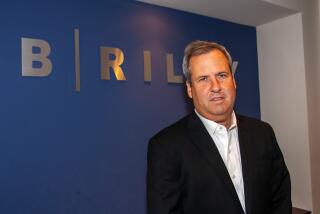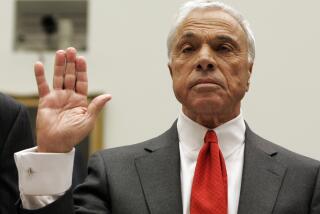Good Hedges Make Good Neighbors--O’Neil Aide Is Setting Up Shop of His Own
- Share via
Do you have a spare $250,000 and a penchant for high-octane growth stocks? If so, David Ryan, a former top aide to Investor’s Business Daily newspaper founder William O’Neil, may have a hedge fund for you.
Ryan, 39, recently left his mentor’s namesake company, William O’Neil & Co. in West Los Angeles, after 16 years. He plans to open Ryan Capital Management in Santa Monica on July 1.
Ryan, who was considered close to O’Neil and is mentioned in O’Neil’s well-known book, “How to Make Money in Stocks,” described the split as amicable.
“He was disappointed I was leaving but he wished me luck,” Ryan said.
He said he’ll follow most of the tenets of O’Neil’s famed “CANSLIM” investment system, which seeks companies with strong revenue and earnings growth whose stocks are moving steadily higher.
CANSLIM largely dismisses traditional stock valuation gauges such as price-to-earnings ratios. Instead, it relies in large part on technical analysis to buy stocks just as they break out of “bases” into new high ground.
O’Neil used his CANSLIM formula to amass a considerable fortune in the last three decades, part of which he used to found Investor’s Business Daily, which began publishing in April 1984.
CANSLIM is an acronym. The C stands for current quarterly earnings and the A for annual earnings. O’Neil looks for stocks where both are strong and growing. The N is for new. One force driving a stock higher, O’Neils believes, is investors’ excitement over something new such as a product or management team.
The S is for supply. All other things being equal, a stock with a relatively small number of shares outstanding is preferable because it’s more likely to rise if demand is strong. The L stands for leader or laggard. Investors should seek out stocks that are leading the market, not lagging it--even if they have to pay up for such stocks, O’Neil says.
The I is for institutional sponsorship, meaning the number of big investors who own the stock. Ideally, O’Neil says, small investors should look for stocks owned by a minimum of three to 10 institutions. But they shouldn’t have too many big sponsors. Why? Because buying pressure from big players is the fuel that drives stocks noticeably higher, a process that already may have taken place in a stock with excessive institutional ownership.
M stands for market. Put simply, the six other precepts work well under the right market conditions. But if the market is falling, stay on the sidelines until stocks are headed back up, O’Neil preaches.
While Ryan says he’ll stick with that basic formula, he also will buy some stocks on weakness, provided their fundamentals remain intact. By contrast, O’Neil won’t buy a stock that’s tumbled until after it has fully retraced its loss and is again making new highs, Ryan said.
Ryan’s will be a “directional” hedge fund, meaning that it will take both long and short positions on stocks depending on the condition of the market.
Ryan ran O’Neil’s former mutual fund, the New USA Fund, for about five years until it was sold in 1997 to Massachusetts Financial Services. The fund lagged the market in 1992 and ‘93, Ryan said. In the following three years, its 66.8% cumulative return handily beat the 40.2% showing of the Russell 2,000 small-cap index, according to Lipper Analytical Services.
But New USA still lagged the 71.4% gain notched by the blue-chip Standard & Poor’s 500 index--a disappointment to investors who were attracted to the fund by the legend of O’Neil’s market-beating performance.
The $200-million fund was sold so that the company could concentrate on trading for its own proprietary account, Ryan said.
Ryan joined O’Neil in 1982 after walking into the company one day and asking for a job. O’Neil agreed to meet with him the next day and, after Ryan said he was a fan of O’Neil’s investing style, was given a part-time job paying $5 an hour.
More to Read
Inside the business of entertainment
The Wide Shot brings you news, analysis and insights on everything from streaming wars to production — and what it all means for the future.
You may occasionally receive promotional content from the Los Angeles Times.









